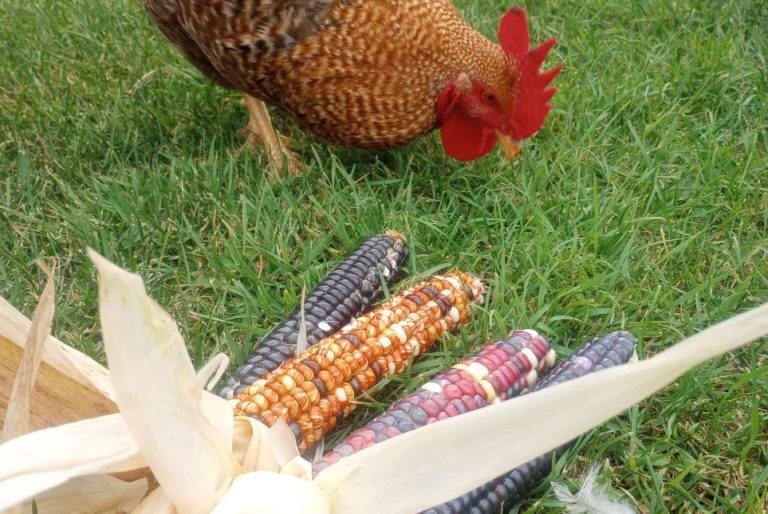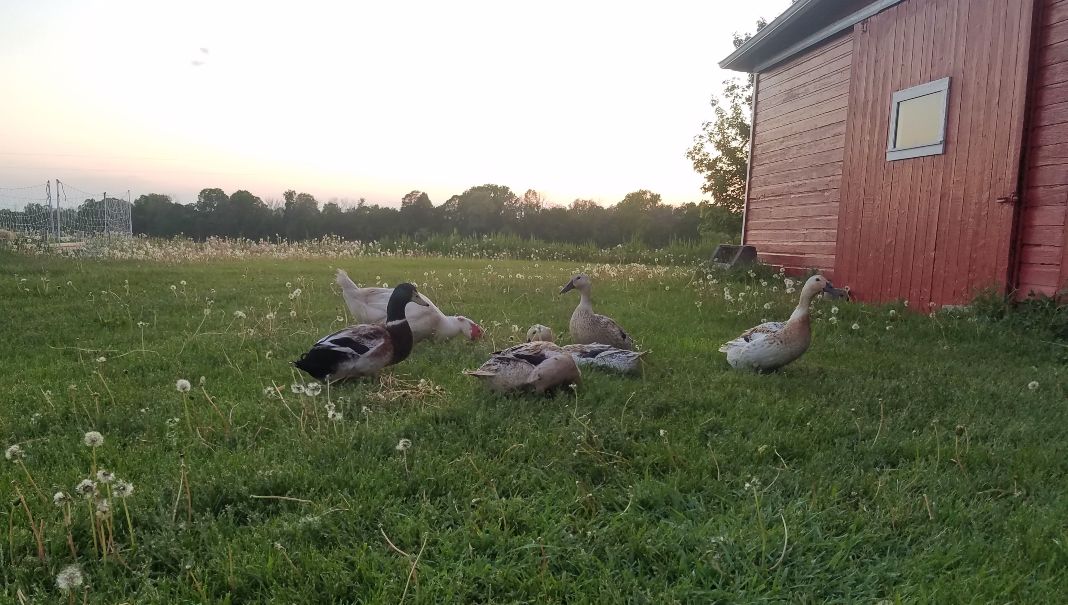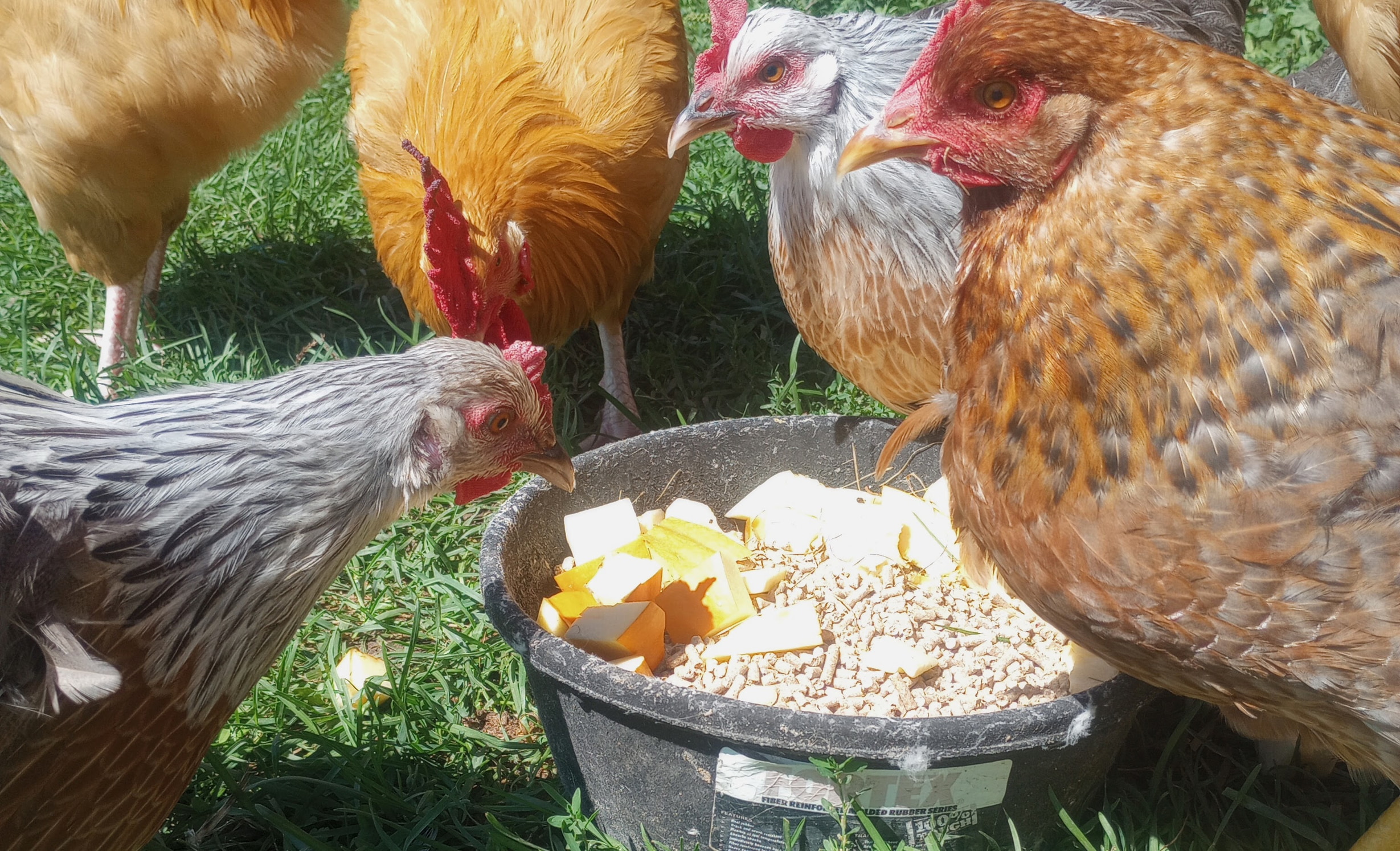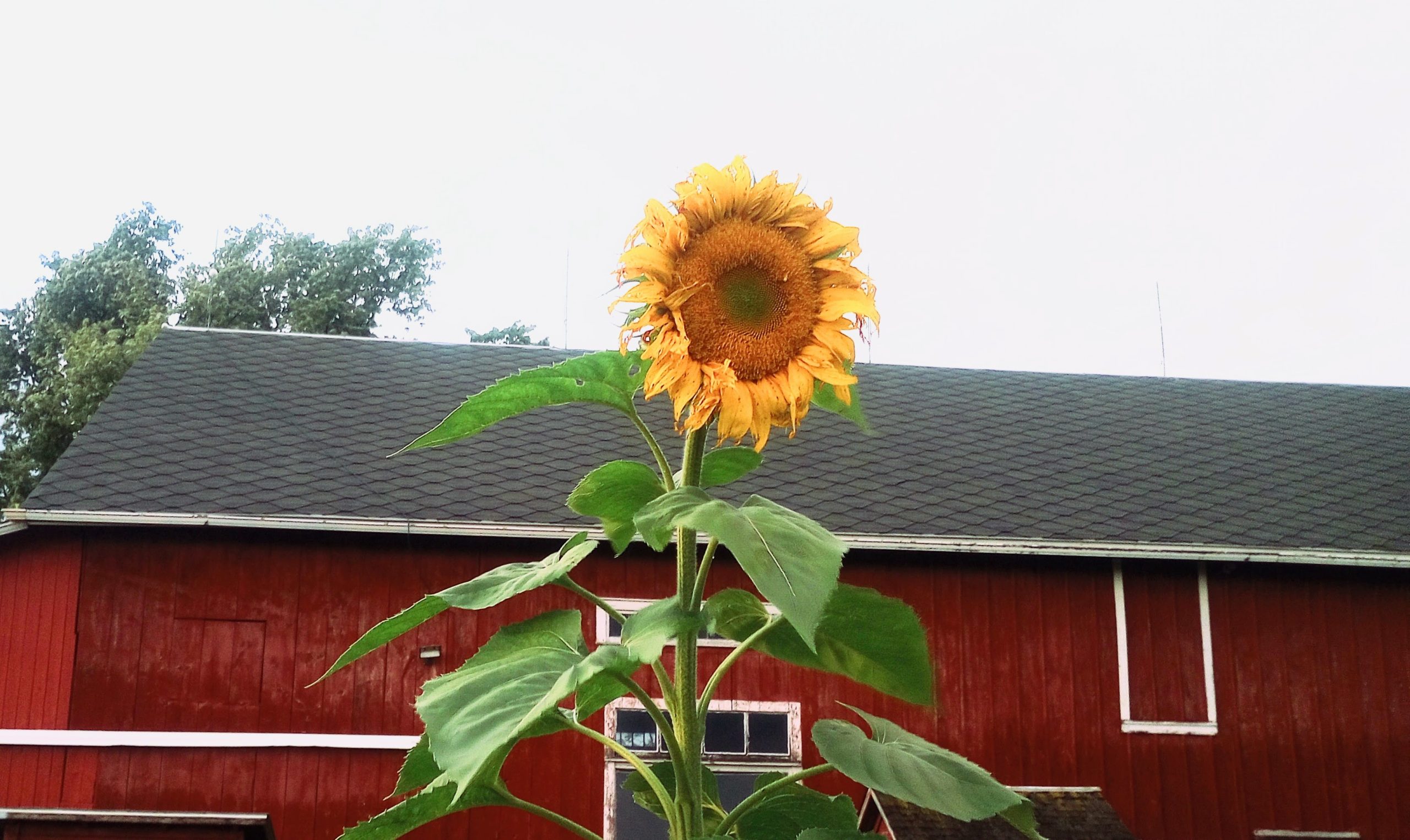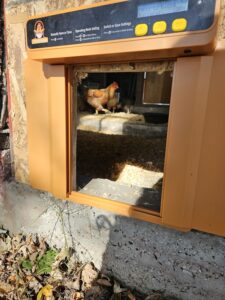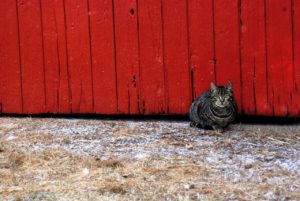Table of Contents
When you want to become more self-sufficient, chickens (or ducks) are a great place to start. But feeding chickens can get really expensive really fast.
Especially in 2022, when feed costs seem to rise weekly, it’s even more important than ever to find cheap chicken feeds.
Here’s a list of seven great ways to save money on chicken feed. For your convenience, I’ve also provided my personal notes on the ease of use and cost of each method.
1.Free Range
Ease: 1/10 – very low effort, Cost: 2/10
One of the easiest ways to get cheap chicken feed is to let your birds harvest it themselves!
Chickens and ducks allowed to free range can forage up to 20% of their feed.
Free-ranging allows chickens to harvest their own grasses, weeds, herbs, worms, flies, and other grubs. Free ranging can supply your birds with various nutrients and lots of protein!
Pros:
- Free-ranging is easy, all you need to do is let your chickens out and watch them harvest their own cheap chicken feed
- Great mental stimulation. Chickens will get hours of entertainment, exercise, and socialization from free-ranging
- Free pest control – chickens will eat fly larvae, mosquitoes, beetles, slugs, and more!
Cons:
- Free-ranging may not be feasible if you have close neighbors
- You will need to fence in your garden (or any other area you wish to keep chickens out of), incurring cost
- Chickens are at a higher risk of predator attack, but this risk can largely be mitigated by locking chickens up at nighttime
- Chickens and ducks will benefit most during spring & summer, and they will forage less food during the cold seasons
2. Plant a Poultry Pasture
Ease: 4/10, Cost: 4/10
Planting a poultry pasture is a step up from free-ranging your birds onto whatever pasture area you have. Planting a poultry pasture is a great cheap chicken feed because it allows you to reap the benefits of growing grain for your birds without the hassle of harvesting and storing.
Once you’ve figured out where your poultry pasture should be, kill off anything that may already be growing and sow your pasture mix. Grains like wheat, amaranth, and millet are great choices for poultry to self-harvest. Adding in alfalfa and clovers will provide poultry-friendly greens and seeds almost year-round. You can also plant herbs like lavender, rosemary, thyme, and oregano for their health benefits.

I love Nature’s Seed pasture mixes – this company provides dozens of pasture mixes designed with both livestock nutrition and your region in mind.
Pros:
- An intentionally planted poultry pasture may provide more concentrated and high-quality nutrition than free ranging in your barnyard
- Letting birds self-harvest grains and herbs provide the health and nutrition benefits of these plants without the labor involved in harvesting and storing them
- A small, densely planted poultry pasture may be more efficient than traditional free-ranging for small properties
Cons:
- You will need to pay for seeds to plant the pasture
- Other possible costs may include fertilizer and fencing
- Depending on your climate, you may only be able to use your poultry pasture during certain seasons
- Most of the cons from traditional free-ranging also apply to poultry pasturing
3. Raise Black Soldier Fly Larvae
Ease: 1/10, Cost: 3/10
Black soldier fly larvae are one of my favorite cheap chicken feeds because it reduces household waste while providing high calcium, high protein chicken & duck food.
Black soldier fly larvae readily consume all your household food waste – yes, all, everything from fruit and vegetable peelings to baked goods, meat, and dairy products. Black soldier fly larvae have little teeth and literally take bites of their food. The only thing black soldier flies can’t consume are bones, shells, and highly fibrous things like hay and wood.
Even if you’re squeamish, you can still raise BSF larvae because these wonderful little grubs self-harvest when they’re at peak nutritional value. As if turning your food scraps into chicken food wasn’t enough, BSF larvae also quickly turn your food waste into high-quality compost and liquid fertilizer to feed your garden. Learn more about raising BSF larvae here.

Pros:
- BSF larvae can be overwintered, meaning you only need to purchase the grubs once
- BSF larvae are easy to breed and can multiply their population many times over in one year
- BSF larvae are a great source of protein and calcium
- BSF larvae growing pods are reasonably cheap, usually under $200, and there are many DIY plans available online
- BSF larvae produce garden compost to feed your plants
- BSF larvae farms are easily scaleable, giving you the opportunity to sell excess grubs to local bird and reptile owners
- Great way to reduce household waste
- Live grubs are a great boredom buster for chickens
Cons:
- You need to purchase the larvae and a growing pod
- Larvae will need extra care during winter when they go dormant
- There can be an offensive smell associated with BSF larvae farms
4. Feed Kitchen Scraps/ Compost Pile
Ease: 1/10, Cost 1/10
As I mentioned in the previous section, kitchen scraps can be valuable resources for feeding chickens. You can directly feed your kitchen scraps to your poultry as a supplemental cheap chicken feed.
Chickens will enjoy most chicken scraps like fruit and vegetable peelings, produce on the edge of going bad, nuts, seeds, and even meats. Chickens are omnivores, and they’ll eat almost anything you put in front of them.

Chickens are pretty good at knowing what not to eat, even so, you shouldn’t give them large quantities of raw legumes, stalks and leaves from nightshade plants (like tomatoes and potatoes), raw potatoes, chocolate, alcohol, or overly processed food.
Here’s a more exhaustive feeding list for chickens and ducks.
Just as people do, chickens and ducks will nutritionally benefit from a varied diet. They’ll get Vitamin A from carrots, potassium and Vitamin B6 from cooked potatoes, and lots of Vitamin C from bell peppers.
To save time, you can simply let your chickens dig through your compost pile. Whatever they don’t eat will be left on your pile to break down, while the chickens eat their fill of fresh produce and deposit manure into your compost. Win-win!
Bonus! As your compost ages, it will be inhabited by various insects and grubs (biota) that your poultry can also snack on!
Check out this farm tour from Justin Rhodes to learn more about feeding chickens from compost.
To double the value of your kitchen scraps, feed directly to your chickens while also maintaining a BSF farm as I outlined above. BSF larvae can only eat so much food each day. Give your larvae their fill and give the rest directly to your hens!
Pros:
- Feeding kitchen scraps is FREE! You turn food waste you already have into free chicken food
- Makes household waste useful
- Chickens and ducks benefit from a varied diet
Cons:
- Food that chickens pick over will rot on the ground if not picked up or composted
5. Plant a Chicken (or Duck) Garden
Ease: 6/10, Cost: 4/10
I’ll be the first to admit that gardening is not necessarily easy or low-effort, but it takes a lot less than you’d think to make a dent in your poultry feed bill. Growing a chicken garden is an economical way to obtain cheap chicken food for your flock.
The best crops to grow to feed chickens and ducks are potatoes, beets, carrots, and winter squash or pumpkins.
Pros:
- Fresh, nutritious food for your flock
- Offer a varied diet to your flock
- A choice about how feed is produced (organic, chemical free, etc)
Cons:
- Gardening can be difficult and takes up time and space
- Need space to store produce after harvest
Potatoes
Potatoes must be cooked before being fed to poultry, but they pack a mighty nutritional punch. Potatoes are a good source of protein, complex carbohydrates, potassium, Vitamin C, B6, and Magnesium. Potatoes also contain a bit of Iron and Calcium to boot. Potatoes are easy to grow and store well once they’re cured. With correct management, potatoes are relatively disease free and produce large yields.
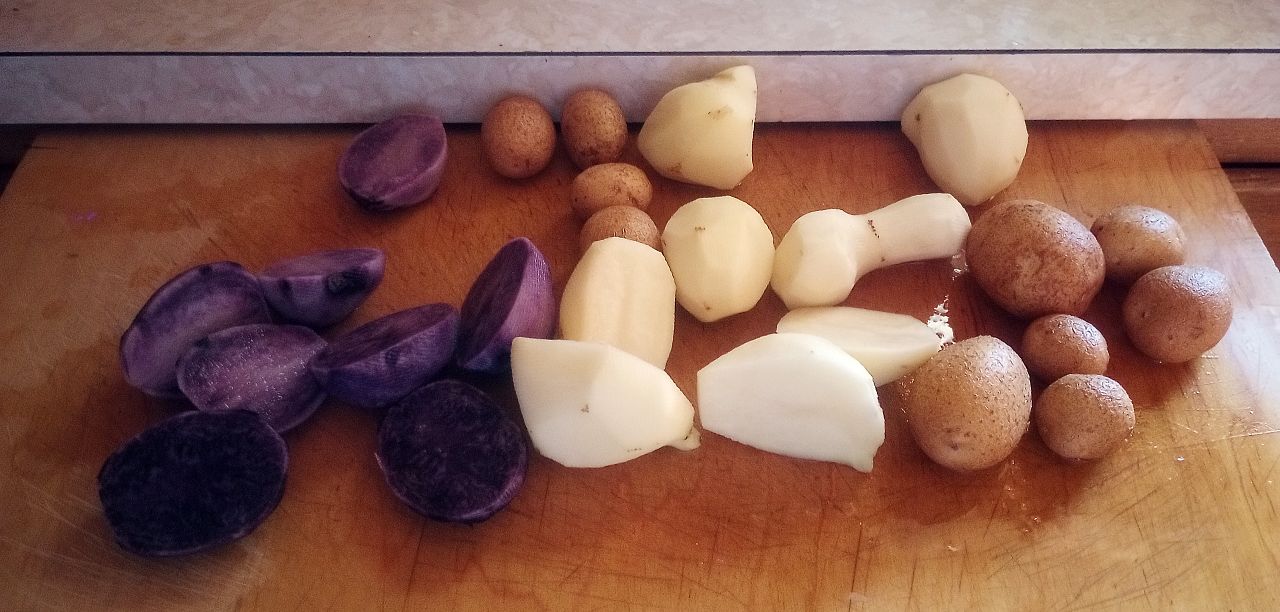
Fodder Beets
Each year, I grow a crop of Mammoth Fodder Beets to feed my animals. Much like potatoes, beets are easy to grow and store well once cured. Mammoth fodder beets are my favorite variety to grow for livestock because they can grow up to 25 pounds each. Beets contain respectable amounts of protein, vitamin C, niacin, potassium, and manganese. Beets can be fed raw, but I prefer to boil and mash or grate beets for my flocks.
Carrots
Carrots are another good root crop to feed poultry flocks. Ducks and chickens enjoy the sugary sweetness of carrots, making them a tasty, cheap chicken feed. Much like beets and potatoes, carrots are usually easy to grow and high yielding when planted intensively.
Carrots are insanely high in Vitamin A and boast respectable levels of Vitamin C, calcium, and iron. Due to their high sugar and low protein content, carrots should only be fed as treats once or twice a week. Chickens may be able to peck pieces of carrots off whole roots, but ducks (and chickens, too) will have an easier time with chopped or cooked carrots.
Winter Squash & Pumpkin
My final favorite crop to grow for cheap chicken feed is pumpkins/winter squash. As with the others in this list, these vegetables are nutrient-dense, easy to grow and store well. Of course, the exact nutritional composition of winter squash will vary by variety, but, generally speaking, winter squash is high in vitamins A, C, and B6. Winter squash and pumpkins also supply some protein, fats, and fiber. Some pumpkins also contain significant levels of Vitamin K, vitamin E, iron, magnesium, manganese, potassium, and others.
There’s a great reason that Native Americans included squash in “Three Sisters” gardens. Squash is a very nutritious, prolific plant that stores well and provides high-quality fuel to humans and animals alike.
Herbs & Others
Some other great crops to grow for poultry include corn, millet, cabbage, sweet peppers, berries (cherries, blackberries, mulberries, etc), legumes (cooked), sunflowers, melons, and others. Chickens and ducks can eat most crops; but be sure to avoid the leaves of nightshade plants (like tomatoes and potatoes), avocado, citrus, onion, avocado, uncooked rice, and rhubarb.
I’ve fed my flocks samples of nearly everything I grow in my garden, some things they eat, others they ignore. But the great thing about this method of obtaining cheap chicken feed is that it pairs wonderfully with strategy number four. If you aren’t sure your hens will finish a particular crop, offer it to them in your compost pile. That way, the hens can happily pick through and eat what they want, and uneaten food will compost into garden soil!
Since we’re talking about growing a poultry garden, now is a good time to mention that many herbs can be beneficial to poultry as well. Lavender can be sprinkled around the coop to promote relaxation and keep the air smelling fresh. Herbs like oregano and rosemary offer health benefits. And mint makes a great addition to water drinkers to help cool your birds down on hot days.
Lisa Steele, the author at Fresh Eggs Daily, has a great article that goes further in-depth about using herbs in your poultry flock.
6. Seed Sprouting for Fodder
Ease: 1/10 Cost 3/10

Microgreens are sprouted seeds that are eaten well before the plant matures while it’s still small; hence the name “micro” green. Microgreens are incredibly nutrient-dense and generally have higher levels of antioxidants, vitamins, and minerals than mature plants. Microgreens also taste amazing and make a great addition to any recipe!
Read about how and why you should grow microgreens in this great article from Katie Krejci at The Homesteading RD.
Think of fodder growing as your livestock’s version of microgreens. Growing fodder is really quite simple. You throw a bunch of seeds in a tray, water it, and in a few days to weeks, you’ll have a tray of fresh, nutritious fodder for your poultry to enjoy.
The great thing about growing fodder is that it can be done at any scale and allows your animals to reap the benefits of free-ranging even in the dead of winter.
Growing trays of fodder is a great way to stretch your chicken feed. When seeds sprout, their nutritional content is enhanced and their volume increases. Some fodder seeds can triple their volume when sprouted!
Sprout the grain that your chickens would be eating anyway like wheat, oats, or rye. Here’s a more in-depth article about sprouting fodder for livestock.
Pros:
- Tender, fresh sprouts any time of year
- Nutrient-dense, tasty food
Cons:
- Requires a grow light for indoor growing
7. Grow Grain
Ease: 9/10 Cost 3/10
Growing your own grain is by far the most labor-intensive strategy on this list; but, done right it can provide nutritious cheap chicken feed.
The planting of the grain itself is pretty easy. Unless you’re cultivating a large field, you can simply broadcast grain in your garden bed using a hand spreader. Alternatively, you can harrow shallow rows one to two inches apart and plant the grain in dense rows.
Grain harvesting, however, is a more involved process. To harvest grain, you have to first cut the mature stalk of the plant. Then, gather up all the grain stems and hang them up to dry for about two weeks. Next, you need to thresh the grain to remove the seed heads from the straw. Finally, you need to separate the chaff (the seed casing and other inedible plant matter) from the grain in a process called winnowing.
Traditionally, winnowing was done on a breezy day and handfuls of grain were tossed up into the air allowing the breeze to carry away the lighter chaff while the heavy grain fell back down. Luckily, these days we have the luxury of fans that allow us to winnow our grain any time, anywhere!
Getting grain from stalk to storage is a lot of work, but wheat berries can last for years when stored correctly.
Your grain yield will vary depending on the density of planting, variety, and season. Sources differ greatly on yield per foot. With wheat, for example, you can expect at least 6 pounds of grain per 100 square feet and allegedly up to 50 pounds.
When I calculated an expected yield based on the USDA average wheat yield per acre, I found that you might expect 6.6 pounds of wheat per 100 square feet. However, this average is based on traditional commercial agriculture which tends to yield less per acre than intensive, small-scale productions. In fact, Alicia Thompson over at the Epic Gardening blog wrote that a backyard gardener could harvest as much as 50 pounds from 100 square feet of wheat.
I’m growing my first crop of Winter Wheat this year, so I’ll let your know how much I harvest!
Regardless of how much grain you grow in your garden, it will still provide nutritious, calorie-dense, cheap chicken feed. And you can make it stretch even farther by pairing it with strategy number 6 above!
Pros:
- Feed grain without paying for the retail price tag
- Control age and methods used in grain production
Cons:
- Space and time consuming
- Requires containers and space to store grain
- Some grains may need to be milled or cooked before being fed to poultry
- May need to buy specialty tools (such as a scythe or seed spreader)
I’ll make sure to update this post as I continue to use these strategies. As I’m writing this, I’m just beginning to harvest my chicken garden, and I’m excited to see my chickens enjoy this food!
Have you ever tried to grow your own cheap chicken feed? Let me know how it went in the comments.
Happy Homesteading!
Now that you’ve slimmed down your feed budget, check out some more practical homestead advice!

